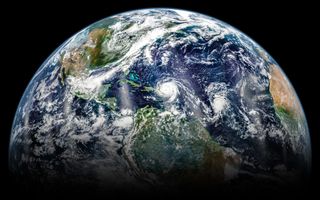
First Responders in Space: How Satellites Save Lives During Natural Disasters

Mackenzie Thompson manages marketing and mission fulfillment initiatives with the Disque Foundation and the Save a Life Initiative, which help communities learn lifesaving techniques like CPR — a valuable skill to have both on Earth and in space. Thompson contributed this article to Space.com's Expert Voices: Op-Ed & Insights.
If we are to save people from natural disasters, we must continue to invest in satellites that further our ability to see the planet, because satellites provide us with important information about our planet.
Not only do satellites enable accurate weather forecasts, but they also assist in mapping areas affected by natural disasters like hurricanes, floods, wildfires and droughts. They also give us the perspective necessary to prioritize how we choose to save the planet by (among other things) delivering lifesaving assistance to individuals and communities throughout the world.
Indeed, the images satellites transmit are transcendent. They show the beauty of Earth — the mountains and the oceans, the rivers and the seas, the continents and the landscapes below. [Earth from Space: The Amazing Photos by the GOES-16 Satellite]
Perspective of this sort determines budgets and directs how space agencies and private satellite- imaging companies plot their missions. Only by seeing how a challenge like a storm formation can become a crisis like a Category 3 (or higher) hurricane — only by seeing the Earth from the viewpoint of the heavens — can we better understand how quickly a danger can become a deadly threat.
By mapping the path of destruction from space, we can warn people to avoid hazardous or impassable areas and chart a different route, while bringing relief to those who neither had the means nor the foreknowledge to leave in time. This intelligence, the images made possible by having launched satellites into orbit, increases the probability of saving as many people as possible.
To see images from these satellites is to know we have the equipment to see better (so we may act faster) than ever before. We should, therefore, equip ourselves to teach everything from Basic Life Support (BLS) to cardiopulmonary resuscitation (CPR), so we can apply the images we receive from above to realize our ability to see images of safety on the ground.
Get the Space.com Newsletter
Breaking space news, the latest updates on rocket launches, skywatching events and more!
We should champion the increased use of Earth-observing satellites, since technology expands at an exponential rate while costs decrease — they are lower — than many may imagine.
We should be champions of action, whose works are visible from any viewpoint, thanks to the deeds we perform and the life-saving skills we help communities practice and possess.
Our acts can be a sight for all the world to see. The results, such as areas evacuated before a storm starts or a tsunami hits land, are something satellites can capture from the low Earth orbit of space. The photographs can not only memorialize our efforts but promote them, too, so we can do more to better our best achievements. Satellites are essential to the outcome of this plan.
With resolve and plenty of high-resolution images, we can strive to save lives worldwide.
Now is the time to launch our mission.
Follow us on Twitter @Spacedotcom and on Facebook. Original article on Space.com.
Join our Space Forums to keep talking space on the latest missions, night sky and more! And if you have a news tip, correction or comment, let us know at: community@space.com.

